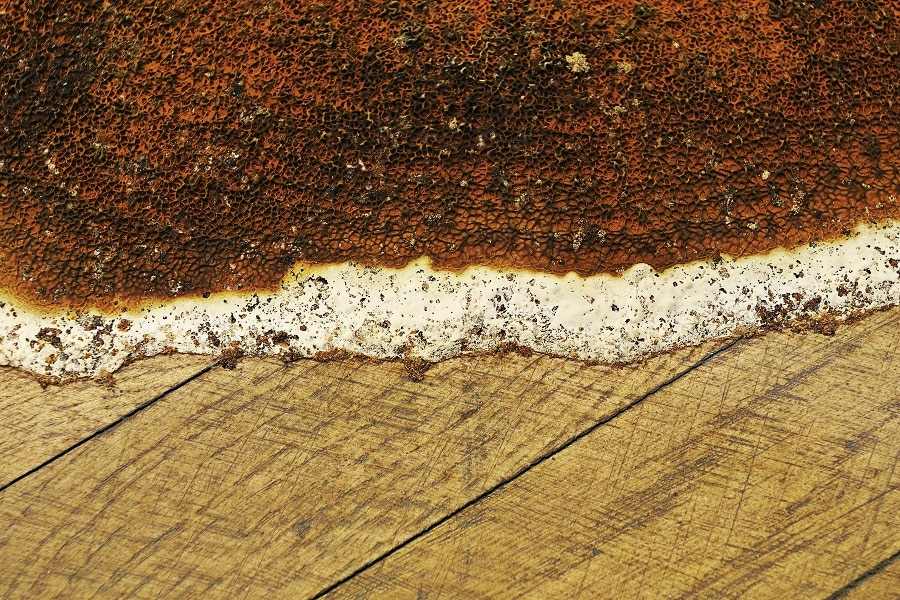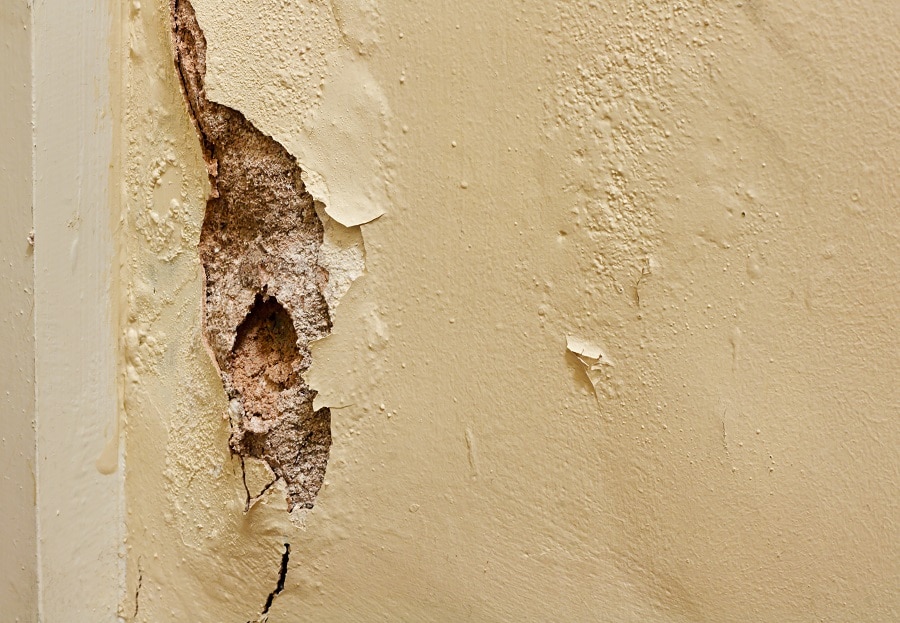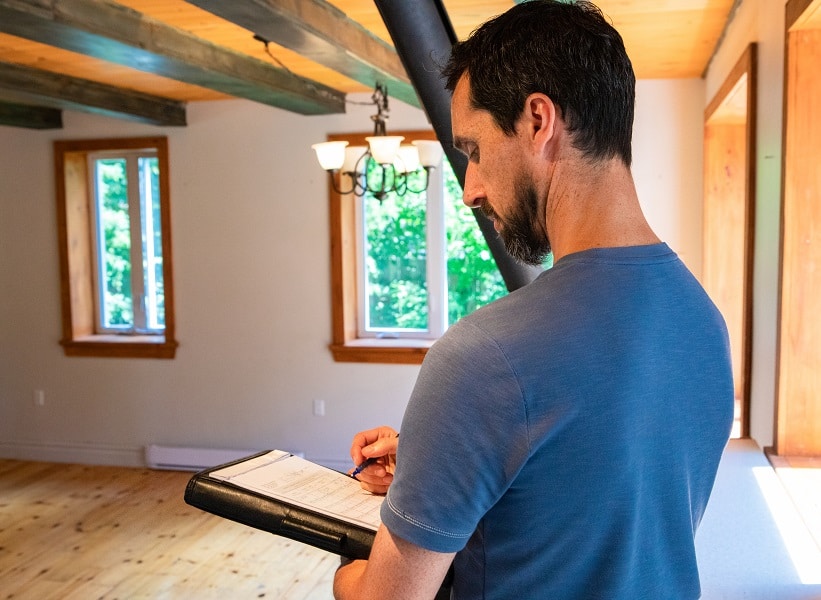What is dry rot?
Wood-decay fungus is often called dry rot. Wood is broken down by Sporocarp (fungi), as the Mycelium consumes the wood, dry rot occurs resulting in fine dust particles, decomposition of the wood and dry rot bloom. Dry rot is caused by fungal spores which require a suitable place to land and start their colonies before spreading through the underlying wood. Many of the spores are already present in woods that are already affected by dry rot and in the soil.
It also means that dry rot cannot live in so-called “humidified” lumber that is kept at 15% moisture with a wetted surface. Dry Rot causes significantly greater damage than Wet rot, you may be shocked to hear that dry rot fungus can attack the structural timber in your property whilst remaining undetected. It usually happens where you are not looking This could be found behind the plaster, beneath your floorboards, or even in your loft. This is why it is important to know the signs and symptoms of dry rot and to have it handled fast.
Our Guarantee
- upto 30 year guarantee
- customer focused team
- 20 years combined experience
- portfolio of satified customers
- attention to detail
- Construction line accreditation
- public liability insurance
- CHAS accreditation
What is the difference between dry rot and wet rot?
Dry rot and wet rot have different spores/species, meaning that they look different. Unlike dry rot which can spread in minimal amounts of water, wet rot is dependent on significant moisture to spread. Contrarily, dry rot does not spread as easily as wet rot. This is because it uses the capillaries within timber rather than mycelium that typically forms the basis of a Dry Rot infestation. Dry rot fungus can be “silent”, but it is very active and spreads incredibly quickly once it has taken hold in a property. Wet rot fungus, on the other hand, occurs more often but is less serious, usually, the decay is confined to areas where the timber becomes and remains wet.
Call Our Sussex Damp Experts team now for quote, consultation and advice:
Call on 01273 257 765.
What are the causes of dry rot?
Dry rot is caused by different species of fungi. Serpula Lacrymans is the most common one in East-Sussex. If it’s not handled fast enough, it’s going to spread over your house, brick and mortar, and even plaster. It can have a major negative impact on the structural integrity of timber, and also the integrity of your home. Dry rot attacks when you have an unhealthy amount of moisture in your timber. This will attract the fungus that will use this moisture to extract nutrients. The word “dry rot” is used to differentiate between “wet wood” and “dry wood rot.”
Wet timber feeds on dry rot. In order to develop spore-bearing structures, the fungal spores need over 30% dampness to generate hyphae after this, however these hyphae merely need 20% dampness to last. This hyphae can develop into a fungal body known as mycelium, which can disperse and find more wood in brick and stone. H2O, Hemicellulose and cellulose can be stripped from the timber by this fungus, leaving behind a fragile structure of the original wood. You need an expert to examine your property and determine whether your rotting timber is a result of dry rot or a different type of fungus. This is important as the remedies for these damages can vary based on the actual cause.

The dangers of dry rot in East-Sussex
Dry Rot Effect on your Property
Dry rot can be highly detrimental to the integrity of your home. It will spread along the structural timbers inside your property and begin to break them down. In serious circumstances, it can cause various parts of your house to fall apart. Dry rot does not strike your brick or stone, it just moves through it. This is why regular checks are important.
Dry rot is a ravaging condition that affects your home and must be addressed immediately. When fungus is evident, you need to call a restoration expert right away to prevent mold growth from worsening any damage that may be apparent. If you think you may have a damp problem use our home survey form on our website.
Dry Rot Effect on Your personal health
The fungus that causes dry rot does not cause harm. Dry rot is a fungus that can be harmful to your health if you allow it to occur. If you suffer from respiratory problems, asthma or allergies and don’t have a smoke alarm, then this guide is for you.
What are the Warning Signs of Dry Rot?
Discovering dry rot early is essential to preventing devastating and costly damage. If any of these signs and symptoms are present, a formal evaluation is recommended.
-
The beginning of the dry rot cycle
The spores of the dry rot fungus are carried by the wind across large distances. They may be nocturnal but they will also feed on timber during the day if there are carried onto timber. When they feed on it, they will then germinate and create hyphae, if the timber is giving them enough nutrients to do so. The hyphae grow and join up into a lot of tangled spaghetti-like threads called mycelium. Mycelium is white or grey Mycelium is mostly found between property’s bricks, mortar and plaster and can also try and spread into timber greatly.
-
Your timber is damaged.
It affects every part of the wood, from the bark to the core, causing it to wither and die. Your timber may collapse as a result of this. You may observe the dry rot changing the color of your timber. Specifically, dry rot can cause something called cuboidal cracking. Cuboidal cracking/splitting is the result of timber breakage around 50 mm. Sometimes, this damaged wood may also have hyphae, white fungal growth. Hyphae may appear like cobwebs, which is a common sign of dry rot.
-
Your timber will smell.
If your wood is infected by dry rot, it will have a different, fungal smell. This can happen even if you can’t see the outbreak of dry rot. Just because there is a smell, however, does not mean that dry rot is present.
-
Your timber will have fungus bodies on it.
The most noticeable stage of dry rot is the final stage. Mushrooms such as fruiting bodies might start to join themselves with your timber. If it becomes dry, dry rot can no longer feed on the wood so it will pop out spores instead.
-
Your timber will have spore dust.
Dry rot can affect a variety of timber that is not necessarily already rotten and damp. It is a sign of dry rot when splotches of corroded dust embedded dry rot spores. In the final cycle of the dry rot, fertile bodies deliver this spore dust.
Dry Rot Treatment in East-Sussex

A Dry Rot infestation can only occur when moisture levels are above 20%. The first prevention step to eradicating the presence of the fungus is the monitoring of moisture levels in your property. You are now in charge of the moisture levels. Consult a professional for a proper treatment of your dry rot.
For the removal of infected timber and any remedial work, you can rely on Sussex Damp Experts . A professional should remove any infected timber. The required treatment lies on the knowledge of a dam proofing expert. Timber treatment can be into the timber, or on the surface of the timer. Options for preventive treatment are many. Such chemicals require precise concentrations and can have adverse side effects if mistakenly inhaled or injected.
Boron rods can also be inserted into your timber by an expert. Boron is a hazardous mineral, so it is important to wear protective clothing whilst damp proofing your basement. Through our damp proofing expert team, we will be able to identify some dry rot problems and determine the seriousness of the problem. If left untreated, dry rot can lead to the structural failure of a wooden structure. In order to protect a wooden structure, it’s critical to treat dry rot immediately. We will provide a damp proofing solution that is right for your needs. Please don’t waste time. If you believe you have a problem with dry rot, call 01273 257 765 for a free survey, and successful care today.
How can you prevent dry rot damage in East-Sussex?
The first treatment phase is the removal of dry rot. A rot infestation is caused by water penetrating the timber and it’s inability to dry out, either due to poor ventilation or air-tight construction. Any activities that prohibit them from evolving are present here: Always ensure there are no leaks in your property. Provide proper, sufficient ventilation.
Ventilate the attic correctly and wrap it. Properly ventilate crawl spaces. Seal basement and crawlspace floors to reduce ground moisture. Check all flickering walls and roofs to ensure that the water is adequately directed. Ensure clear downspouts and drains. Check for filling/heating leakage if a “wet” device is used. The best way to reduce the chance of dry rot is to minimize moisture levels, considering the moist conditions needed for dry rot fungus in feeding and germinating. For example, plugging the leak will help avoid dry redness by providing a pipe that leaks.
Speak to a Dry Rot specialist in East-Sussex
We are a team of highly trained experts who will fix your dampness and help you to avoid future damage. We’ll do a full steam survey of the property and give you a free estimation before we start any work. Over the years, we have helped thousands of East-Sussex homeowners with their damp problems, and we can help you too. You can get in touch with us for a free consultation and quote on 01273 257 765. A trained professional can examine the area to identify the source of your water damage, and recommend a solution. This helps us to offer unbiased guidance and advice about the sort of care you will require.

We have a complete list of expert surveyors who carry out all types of surveys and assessments, from pre-purchase surveys to full structural repairs. Dry rot is very destructive and can quickly spread through a home causing an irreversible amount of damage to the entire house, it is essential to reach us immediately. The South Damp Proofing services will assist you in solving your dry rot dilemma by e-mail or calling the phone 01273 257 765.
FAQ
Should dry rot be restored or replaced?
A certain level of dry rot can be repaired, but whether the damaged areas provide the house with structural stability, such as beams and joints, or even flooring, it is not recommended. Replace the wood in such a situation instead of repairing it. Whether you restore or rebuild the wood, it is better if you avoided the conditions that caused the rot to flourish in the first place or risked it coming back. Your roof leaks, broken gutters, or downspouts, plumbing leaks or insufficient ventilation should be inspected when considering a roof moisture accumulation You may consult a specialist to find and repair the problem.
Will you be able to treat my Dry Rot problem effectively?
With our expertly trained surveyors and specialists, a dry rot problem can be treated, rectified, and your timber can be protected for the future.
How do I discover how far Dry Rot has spread?
If you have traced the dry rot fungus quickly or not, a professional will identify the source of the problem. They will be able to trace the fungus in the different masonry and plaster from which it has spread.
How much can dry rot widen?
Dry rot spores can spread in anyplace with the right environmental settings. The reason is that they are carried in the atmosphere. If your timber has a moisture content of around 20%, and if it is in the open air, these conditions are attractive to dry rot fungus. This suggests that fungus groups can disperse to multiple materials. If dry rot is spreading across masonry and plaster, and if it reaches more timber to feed off where the timber is moist. It can widen further. Dry rot fungus needs five things to survive: the right temperature, drive rot spores, moisture, oxygen, and the food source. In any home in Brighton most of this is present.
Will dry rot stretch?
What should I do to control dry rot?
First identify the reason for your timber moist before solving it. A different treatment shall be given if the reason for your timber moisture is outside.
What are the effects of living dry rot unchecked?
Dry rot is the most insidious form of moisture that can infest property and cause permanent damage to the building if left untreated. Sometimes, once the harm is already done due to the places in which the problem is likely to be the presence of dry rot does not come to light.
Is dry rot stringent?
Dry rot can be particularly common in wooden properties, so it is essential that early signs of dry rot are identified before the damage becomes too severe.
How am I meant to know if I have dry rot?
A timber survey will assess how your timber is affected by being exposed to moisture. Later on, fruiting bodies and mycelium will be noticeable in the drive rot life-cycle.
Where can dry rot grow?
Dry rot attacks and rots timber that’s been in contact with water for a long period of time. Although it can often be mistaken for other problems in its early stages, it is important to seek advice. In every structure, both old and new, dry rot can grow. The reason being that it is caused by moisture and wetness that happen anyplace. Dry rot can be caused by leaks or weather, meaning the type of property does not affect it.




